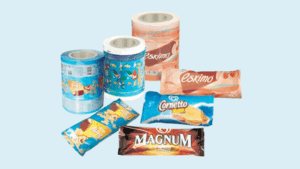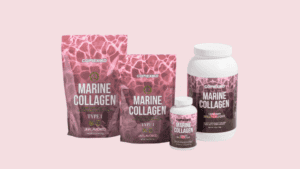Last Updated on February 26, 2025 by Packoi Team
Frozen food packaging is the unsung hero behind every delicious bite from the freezer. It’s not just about keeping your peas and carrots cold; it’s a complex interplay of science, design, and consumer psychology. Every frozen product in the supermarket has been carefully considered to ensure it remains fresh, appealing, and easy to use. Whether it’s ice cream or edamame, the packaging has a big job to do.
In this guide, we’ll peel back the layers of what makes frozen food packaging crucial. From preserving the integrity of the food to making sure it catches your eye in a sea of options, we’ll explore the strategies that make packaging a pivotal part of the frozen food experience.
So, without further ado, let’s get into it.
Importance of Frozen Food Packaging

Ever wonder how your frozen favorites, like frozen vegetables and ice cream, stay fresh, flavorful, and ready to enjoy after months in the freezer?
The secret lies in their frozen food and packaging process. This isn’t just about wrapping up food; it’s an art that ensures taste, nutrition, and convenience are locked in, ready for your next meal.
Let’s unwrap the significance of frozen food packaging and its pivotal role in the journey from the factory to your freezer.
The right frozen food packaging does more than just store your food; it plays a crucial role in maintaining food quality, ensuring food safety, and reducing food waste. A study from the American Frozen Food Institute highlights that nearly 40% of all food in the U.S. is wasted, with a significant portion of this loss preventable through better packaging solutions.
Frozen food packaging is designed to withstand extreme cold, keeping the contents inside safe from freezer burn and contamination, which can degrade the food’s taste and nutritional value.
Ready to Get Custom Packaging for Your Business?
start with a low minimum order quantity
Moreover, this packaging is the first thing consumers see, acting as a silent salesman that communicates the brand’s promise and the quality of the product inside. It tells a story, engages the senses, and can even influence buying decisions. In a crowded frozen food aisle, the visual appeal of frozen food packaging can set a product apart, making it more likely to end up in shoppers’ carts.
From a logistical perspective, effective packaging is essential for transporting and storing frozen foods. It ensures that products can be efficiently stacked, stored, and shipped without damage, maintaining the integrity of the food through every step of the supply chain.
The development of innovative packaging materials and technologies has also allowed for an extended shelf life of raw food, reducing the need for preservatives and offering consumers fresher-tasting food.
6 Types of Frozen Food Products
Venturing into the frosty zone of the supermarket reveals a diverse array of frozen food items, each demanding unique packaging solutions to preserve freshness and ensure safety. Let’s delve into the assortment available and examine how frozen food packaging plays a vital role in each category.
1. Frozen Meats and Seafood
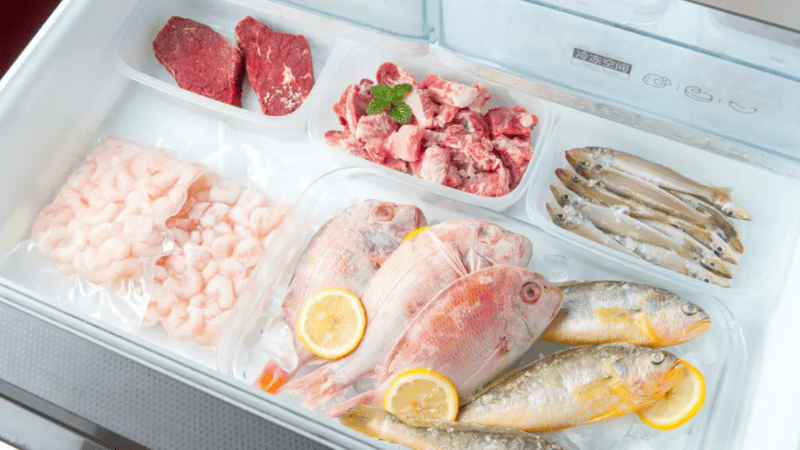
This segment of the frozen food packaging industry includes a variety of proteins, such as beef, poultry, and fish, all of which require packaging that can withstand freezing temperatures while preventing food spoilage.
Advanced frozen food packaging materials like plastic films and vacuum-sealed bags are key to keeping these items in prime condition by guarding against ice crystals and preserving texture and flavor.
2. Frozen Vegetables and Fruits
Offering off-season availability and convenience, frozen fruits and vegetables need clear, robust packaging to safeguard their nutritional content and visual appeal. Packaging solutions that protect from cold air fluctuations are essential, ensuring these perishable goods remain as nutritious and tasty as their fresh counterparts.
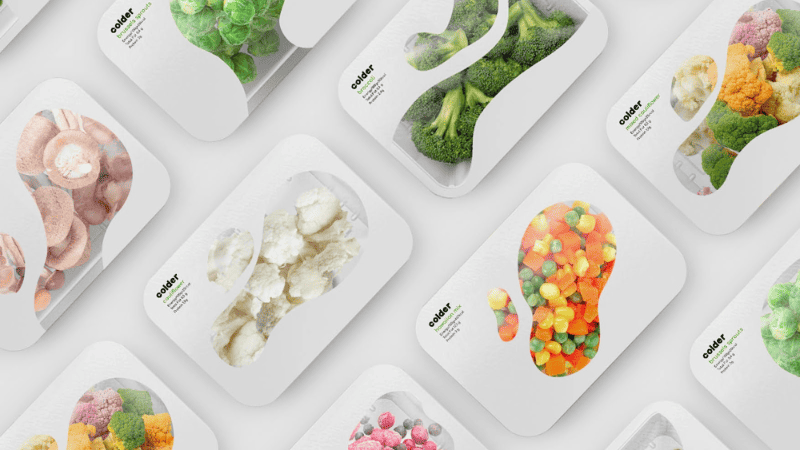
3. Ready-to-Eat Frozen Meals
The bustling lifestyles of today’s consumers have heightened the demand for frozen meals. Packaging that displays nutritional information, heating instructions, and food safety guarantees is crucial. Flexible packaging options, including stand-up pouches and tray seals, enhance user convenience by facilitating easy preparation.
4. Frozen Desserts
From sorbets to ice creams, frozen desserts require enticing packaging that captures the richness and variety. Packaging designs that combine aesthetic appeal with functionality, such as resealable lids or easy-open wrappers, help maintain product integrity and stimulate repeat purchases.
5. Frozen Pizzas
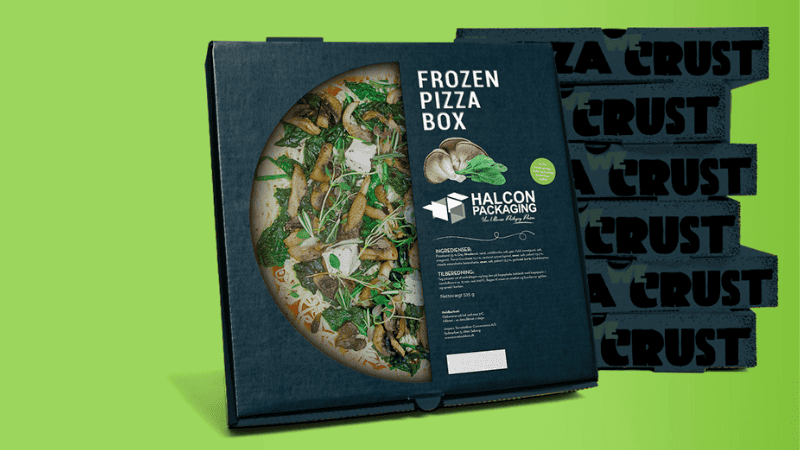
Diverse in toppings and crust styles, frozen pizzas benefit from packaging that locks in freshness while showcasing the product’s quality through vibrant packaging designs. Cardboard boxes with protective plastic film overlays can keep the pizza safe from freezer elements while tempting consumers with visuals of the delicious meal inside.
6. Baked Goods and Dough
This category extends from bread and pastries to pizza dough and pie crusts, all requiring packaging that prevents drying out and food spoilage. Wax-coated paper and plastic containers are often utilized here to preserve the taste and texture of these frozen food products as if they were freshly baked.
What Are the Best Packaging Materials for Your Frozen Food?
Undoubtedly, selecting suitable packaging material is crucial for frozen food manufacturers. Let’s dive into the optimal materials that safeguard against food spoilage and enhance visual appeal, ensuring products withstand freezing and maintain storage life.
1. Plastic Films
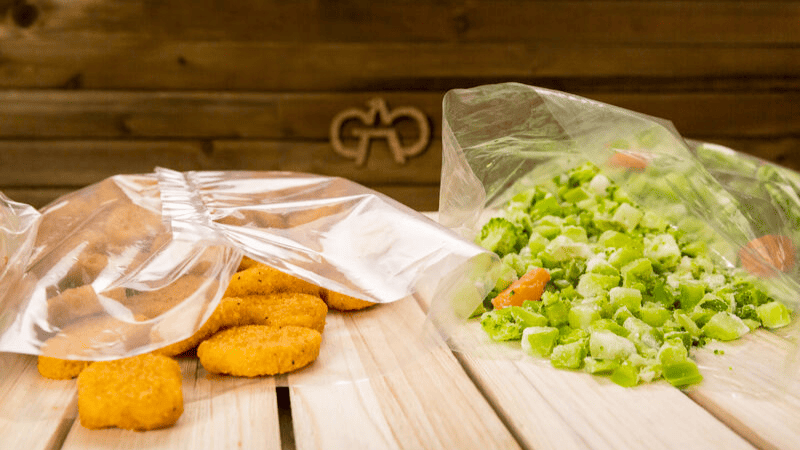
These common packaging materials, primarily plastic films and plastic containers, are flexible and adept at sealing out cold air. Ideal for frozen meat, they create a moisture barrier that fights against ice crystals and off-flavors.
2. PE Derivatives
Known for their durability and moisture resistance, PE derivatives are perfect for frozen packaging of bulk food items, like seafood. They ensure the food product remains protected from external threats and freezes at low temperatures.
3. Paperboard and Cardboard
Lightweight yet sturdy, cardboard boxes are favored for packaging frozen food, pizzas, and meals, with cardboard boxes offering easy customization for food packaging while protecting the contents of cardboard boxes from low temperatures.
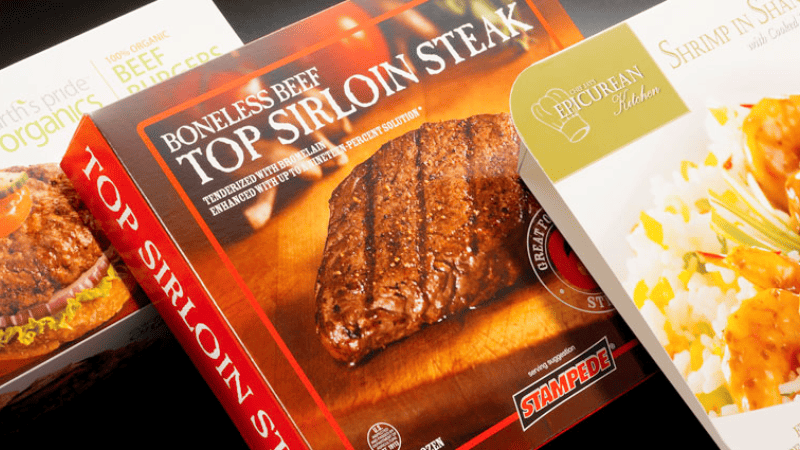
4. Tin Cans
Metal cans and tin cans offer an airtight environment for frozen fruits and vegetables, preserving food-grade quality by preventing exposure to air and light, which is crucial for rapid freezing.
5. Aluminum Foil
With excellent thermal insulation, aluminum foil is suited for frozen meals transitioning from freezer to oven, maintaining even cooking temperatures, and preventing food spoilage.
6. Wax-Coated Paper
This packaging material is best for frozen meat and seafood, providing a wax-coated paper barrier that withstands temperature and keeps moisture in while freezing, ensuring the frozen product doesn’t become cold water soggy.
7. Flexible Packaging (Pouches and Bags)
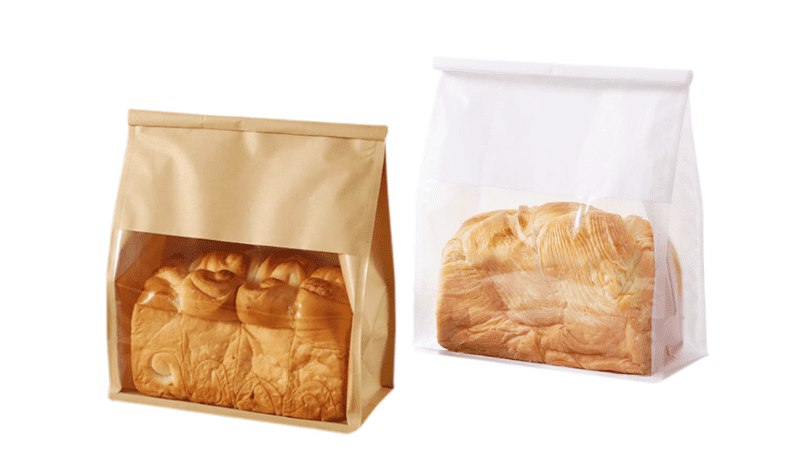
Flexible packaging, including stand-up pouch options made from plastic film, offers convenience for frozen snacks and desserts like ice cream, which are popular for their resealable features and lightweight nature.
8. Rigid Plastic Containers
Rigid plastic materials are chosen for their durability and clarity, making them excellent for packaging frozen food items, fruits, and ice creams, allowing consumers to see the frozen packaging contents while offering protection against impact.
8 Factors to Consider When Selecting Frozen Food Packaging
Choosing the right packaging for frozen food isn’t just about keeping it cold; it’s a complex decision with many layers. Here’s what to keep in mind to ensure your products stand out for all the right reasons.
1. Barrier Protection
Essential for preventing food spoilage and extending shelf life, adequate barrier protection blocks out moisture, cold air, and contaminants. This same sealing technology is critical for maintaining the quality and safety of frozen food products.
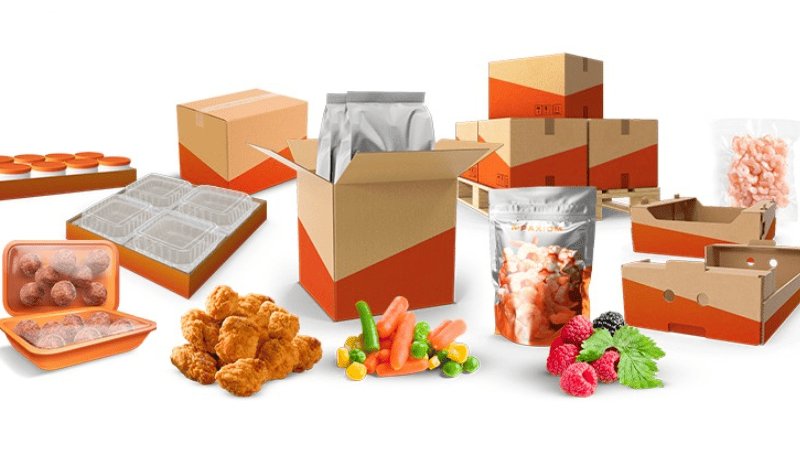
2. Durability and Resistance to Temperature Changes
Packaging must withstand freezing temperatures without cracking or losing integrity. Frozen food packaging materials must be robust to handle frozen products’ freezing and subsequent thawing.
3. Seal Integrity
A strong seal prevents ice crystals from forming inside the package, which can lead to flavor and texture changes. Properly sealed frozen food packaging ensures the food product remains fresh and appealing.
4. Microwave and Oven Safety
Food packaging must safely heat frozen meals and foods that move from the freezer to the microwave or oven. Materials like aluminum foil and certain plastic films are designed for this purpose, offering food safety and convenience.
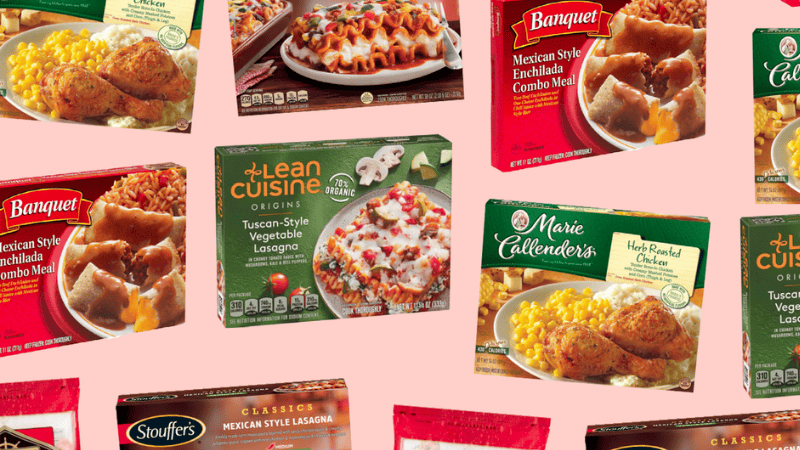
5. Visibility and Aesthetics
Visual appeal plays a huge role in consumer choice, especially in the crowded frozen food aisle. Packaging that offers a clear view of the frozen food inside, along with an attractive design, can significantly impact buying decisions.
6. Consumer Convenience
Features like easy-open frozen packaging, resealability, and microwave safety add value for consumers, making frozen food products more appealing. Flexible packaging options, such as stand-up pouches, often include these consumer-friendly elements.
7. Cost-Effectiveness
While quality is paramount, frozen food manufacturers must also consider the cost of packaging materials. Balancing high-quality plastic packaging materials with affordable solutions ensures that the product remains competitive without compromising protection or appeal.
Ready to Get Custom Packaging for Your Business?
start with a low minimum order quantity
8. Eco-friendliness
Consumers increasingly seek packaging that aligns with their values, including environmental sustainability. Options like recyclable plastic containers, biodegradable plastic films, or wax-coated paper can enhance the brand’s image of environmental sustainability and appeal to eco-conscious buyers.
8 Steps to Custom-Own Frozen Food Packaging
Crafting custom packaging for your frozen food lineup is a strategic move toward branding excellence and fostering a stronger connection with your clientele. Here’s a guided walkthrough to meticulously tailor your frozen food packaging, ensuring it resonates with both your brand ethos and your products’ unique requirements.
1. Define Your Packaging Requirements
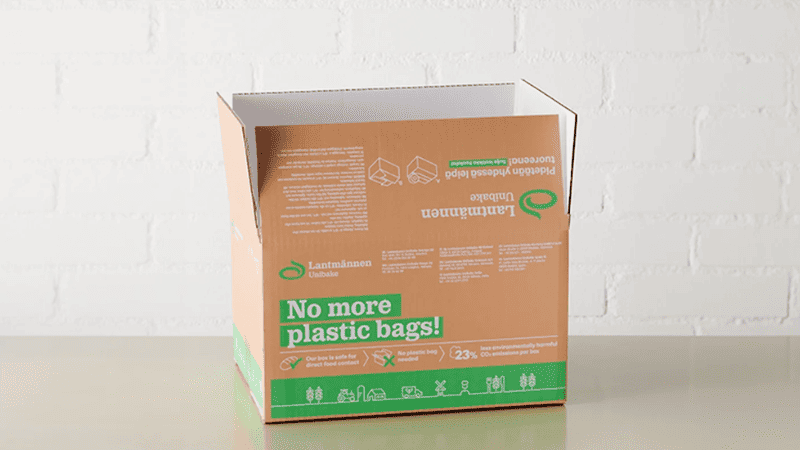
Begin by assessing the specific packaging requirements based on the frozen products you sell. Whether it’s meat products requiring robust barrier protection or frozen vegetables needing clear visibility, understanding these nuances is key to maintaining the quality and extending the storage life of your offerings.
2. Select a Packaging Manufacturer
Partner with a manufacturer who not only brings a diverse array of plastic packaging materials and options to the table but also has a deep understanding of the frozen food market. Their expertise should align with the types of frozen food packaging materials you offer, whether that involves polyethylene film for food-grade safety or aluminum foil for oven safety.
3. Choose the Design of the Package
The design process should consider the specific packaging of the frozen food products you aim to package. A design that enhances the visual appeal of a custom package of your frozen meals can influence repeat purchases. It’s about marrying brand identity with the practical packaging needs of your product range.
4. Decide on the Packaging Material
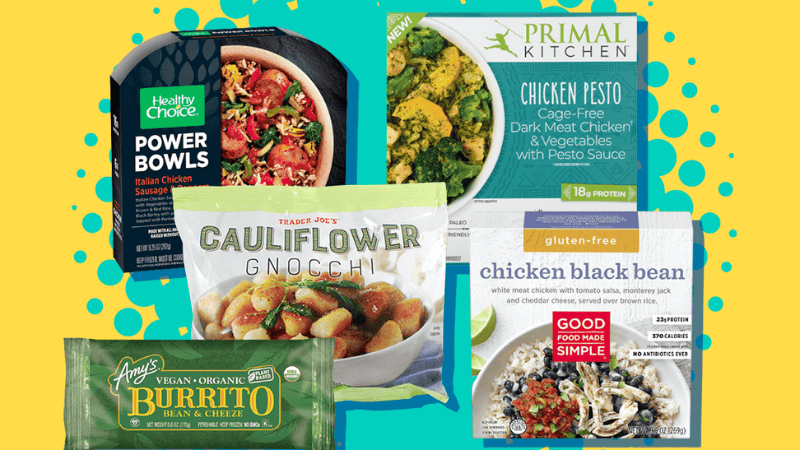
The frozen food types in your catalog must inform the choice of packaging material. For instance, plastic and shrink films might be ideal for items requiring flexible, airtight sealing. In contrast, rigid plastic materials or cardboard boxes could better serve frozen pizzas or meals that benefit from sturdier support.
5. Evaluate Prototypes
Before finalization, test prototypes with a selection of your frozen food products to ensure the first packaging solution effectively meets the demands of freezing temperatures and transportation, safeguarding against food spoilage and ensuring food safety.
6. Consider the Unpacking Experience
Tailor the consumer unpacking experience by incorporating user-friendly features tailored to your frozen products. Easy-open lidding films and resealable closures can significantly enhance end-user convenience, encouraging brand loyalty.
7. Plan for Sustainability
Choose packaging materials that align with the eco-friendly expectations of today’s frozen food market. This decision should be influenced by the types of frozen foods you offer, focusing on reducing environmental impact without compromising the protective qualities needed for your products.
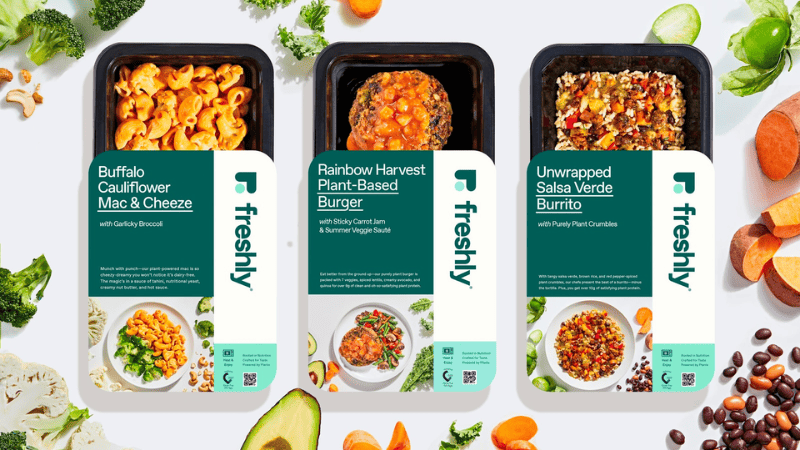
8. Finalize and Launch
With all elements—from material selection to design specifics—tailored to the frozen food you specialize in, finalize the details with your packaging manufacturer. Ensure your launch plan maintains your frozen food’s integrity and visual appeal throughout the supply chain.
Conclusion
As we wrap up our journey through the intricacies of frozen food packaging, it’s clear that the proper packaging strategy for the frozen food industry is not just about keeping food cold; it’s a critical component of product success, consumer satisfaction, and brand identity.
From understanding the various types of frozen food products to selecting the ideal packaging materials and navigating the design process, every step is vital in ensuring your own frozen food product offerings stand out in a crowded market while maintaining their integrity from freezer to table.
Discover the Perfect Solution for Your Business with Packio
For businesses looking to dive deeper into the world of frozen food packaging or seeking innovative solutions tailored to their unique needs, Packoi is here to help. With a wide range of services, from custom packaging solutions to expert design services, we’re equipped to bring your packaging vision to life.
Ready to transform your packaging from functional to phenomenal? Discover more about our capabilities at Packoi, start crafting your unique packaging by exploring our design services, or contact us directly. Let Packoi be the catalyst for your brand’s success in the frozen food aisle.


